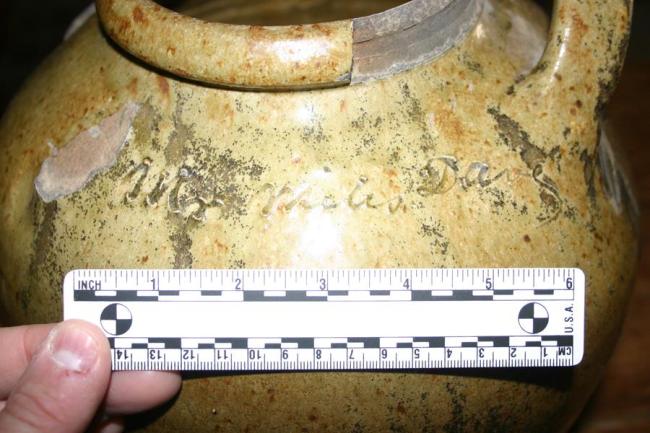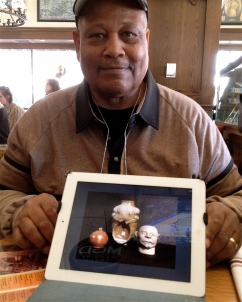The following is from Buddy Wingard, who, with Mark Albertin, created the award-winning documentary, DISCOVERING DAVE. He first posted it on April 1, 2014, on FaceBook.
When Mark Albertin and I first sat down and discussed attempting a documentary about Dave and the context of his life, one of our goals was to create a vehicle that would generate discussion and maybe help to bring to light new insights of his life and story. On February 20th, I was giving a presentation on Dave to the Lexington County Library, when in walked a couple with a stoneware jar. Mr. Michael Blackwell and Mrs. Suedella Rhoten asked me to look at it and quickly I took note it was a strap handled jar – rare – one handle missing, about three or four gallons, and was signed “Dave.” J.R. Fennell of the Lexington County Historical Museum was also there and we both were duly impressed by this new “discovery”. As the time drew closer for me to start my talk, everyone began to sit down but still chattered excitedly about seeing the vessel. Attention was called and I began my slide show. About half-way through I reach the point where I talk about Dave and the “Silent Period” – roughly 1843 to 1849 when there are no dated or signed pots. Was this because of Dave’s owners at the time (the Landrums ) not wanting him to write on the pots due to their strict beliefs about slaves rights or maybe believing they could also be punished for allowing him to write? I start discussing this point when my brain began to reel – “When was your pot dated?” I blurt out. The couple responds “1845.” In had walked a signed Dave dated during the “Silent Period”, an amazing artifact, and one with new insight into Dave’s life during those six years. At this point of my presentation I become totally discombobulated, thrilled, and a bit overwhelmed! So, with that, a new “Dave” has come forward dated August 16th, 1845 and Mark and I are pretty excited that the film was the springboard for the couple to share their incredible heirloom. The film is doing what we had hoped – helping to further the knowledge of Dave and his story and allowing him to continue speaking to us from across the years.








